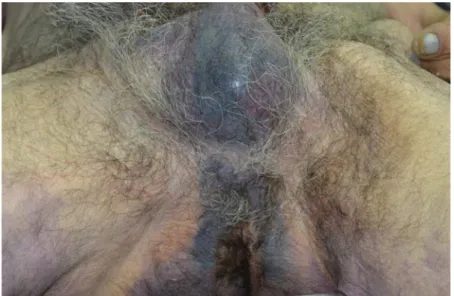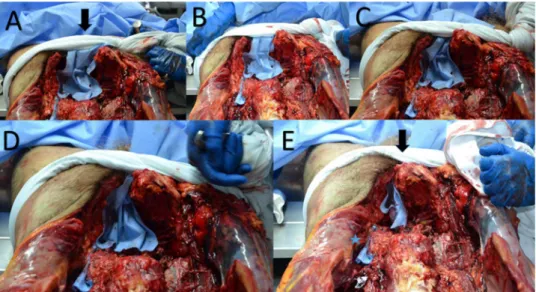Case
report
The
importance
of
pelvic
ring
stabilization
as
a
life-saving
measure
in
pre-hospital
–
A
case
report
commented
by
autopsy
Carlos
Durão
a,b,*,
Magda
Alves
b,
André
Barros
b,
Frederico
Pedrosa
aaNationalInstituteofLegalMedicineandForensicSciences,Portugal bHospitalVilaFrancadeXira,Portugal
ARTICLE INFO
Articlehistory:
Received1December2016
Receivedinrevisedform25March2017 Accepted25May2017
Availableonline30May2017
Keywords: Unstablepelvicring Openbookpelvicfracture Hemorrhagicshock
ABSTRACT
Hipfractureswithunstablepelvicringhavegreatmorbidityandmortalityrates.Thesefracturesresult fromhighenergytraumasuchasfallsfromheights,roadaccidentsandcollapsingstructuresorother similarmechanismsofaction.Wereportthecaseofa63yearsoldman,constructionworker,whostood insideaditchduringawallconstructionwhenhewassurprisedbythiscollapse,whichresultedindirect traumatotherightthighandpelvis.Theautopsyrevealeddiaphysisfractureoftherightfemurwithan openbookpelvicfracturewithseverehemorrhagicinfiltrationandhematomaofthepelvicmuscles without arterialinjury. Bonebleeding and the vascular damageassociatedwith disruption of the sacroiliacligamentspromoteaverysignificantbleeding.Simplemaneuverssuchassheetcircumferential compressiontopromotepelvicringclosureareeffectiveonstabilizingandclosureofthesacroiliacjoint. Hipmanipulationofthefracturewasperformedduringthenecropsytodemonstrateandprovehowa simplesheetcontentioncanpromotestabilizationofthepelvicringbyclosingthesacroiliacjointsin openbookfractures.
©2017
1.Introduction
Almost3%ofallskeletalfracturesarepelvicringdisruptions,1
and these are frequently associated with high morbidity and mortality(reportsfrom20%to80%deathrates).2Thesefractures
resultfromhighenergytraumasuchasfallsfromheights,road accidentsand collapsingstructuresorothersimilarhighkinetic actionmechanisms.3Pelvicfracturesresultingfromthese
scenar-iosareoftenassociatedwithabdominal,pelvicorchestinjuries. Vascular lesions and consequent blood loss are the fiercest complications.Hemodynamicinstabilityandhypovolemic shock duetodifficultyincontainingthesehemorrhagesintothepelvic cavitycanrapidlyleadtodeath.Hemorrhagicshockisthemost commoncauseofdeathinthefirst24h.4Thisisthemainreason
whytheselesionsshouldbeearlydiagnosedandstabilizedinthe pre-hospitalsetting.Awidevarietyofpelvicbinderstogetherwith pelvic sheets is available and offer an adjunct to the initial management of trauma patients with pelvic fractures. These devices are referred to as pelvic circumferential compression devices(PCCDs).Themaingoalistoachievefracturestabilityand
regain intrapelvic pressure, which can reduce hemodynamic compromise.
2.Casereport
Wereportacaseofa63-year-oldconstructionworker,whowas working inside a ditchin a standingposition.Therewas 20cm depthconcretewallonhisrightsidewhich suddenlycollapsed (Fig.1)withdirectimpactoveritsrightsidetorsoandlowerlimb. Thevictimgottrappedinthedebrisbutwaspromptlyremovedby itsnon-medicallytrainedco-workers.Accordingtotheirreports, immediatelyaftertheaccidentthepatientwasconsciousand well-oriented,breathingspontaneouslyandwithnoexternalsignsof massivehemorrhage.Theemergencyteamwascalledandarrived onsiteinfifteenminutes.Atitsarrival,thepatientwasstillwell oriented,withanormalbreathingrate andapparentcirculatory integrity (BP of 110/72mmHg and 93 bpm; and well perfused extremities).Hewascomplainingofpainonhisrightpelvisand thigh–areaswithlargebruisesandhematomasbutnoexternal considerable hemorrhage; the right lower limb perfusion and neurologic status wereintact. Over thecourseof one hour his blood pressure graduallydecreased and cardiac rhythmraised, developing hemodynamic instability.Therewas no responseto
fluid reposition with Ringer lactate, and eventually ended in cardiac arrest; resuscitation maneuvers performed by the
* Correspondingauthorat:HospitalVilaFrancaXira,EstradaNacionaln1,Povos,
2600-009VilaFrancadeXira,Lisboa,Portugal.
E-mailaddress:drcarlosdurao@hotmail.com(C.Durão).
http://dx.doi.org/10.1016/j.jcot.2017.05.011 0976-5662/©2017
JournalofClinicalOrthopaedicsandTrauma8(2017)S17–S20
ContentslistsavailableatScienceDirect
Journal
of
Clinical
Orthopaedics
and
Trauma
emergencyteamonthewaytothehospitalwereunsuccessful.The death occurred just over an hour after the accident and was confirmeduponhospitalarrival.
Theautopsyrevealedanopen-bookpelvicringfracture (Young-Burgess lateral-compression type III, Tile type B1) withsevere hemorrhagic infiltration and extensive hematomaof thepelvic muscles. There was no recognizable arterial injury – superior gluteal,pudenda,andcommon,externalandinternaliliacarteries wereintact.Theonlyidentifiablehemorrhagesourceswerethe venousandbonebleeding–whichresultedinabout800mlblood loss.No viscerallesions wereobserved. Noticeably, thepatient presentedaconsiderableperinealecchymosis,asatranslationof hemorrhage, typically associated with pelvic ring fractures –
Destotsign(Fig.2).Thepatientalsosufferedanobliquediaphyseal fracture of the right femur (AO 32-B1). Unequivocally, the determinedcauseofdeathwashemorrhagicshock.
3.Discussion
Pelvic ring fractures can be classified based on type of mechanicalinstability,accordingtoTile’sclassification5(A:stable,
B:rotationallyunstable,C:verticallyandrotationallyunstable);or based on the energy vector, according to Young and Brugess classification6
–lateralcompressiontypes(LC),anterior-posterior types(AP),verticalshears(VS)andcombinedmechanism(CM).
Bothclassificationsareorderedaccordingtotheinjuryseverity, intightrelationtothefracturestability.Whilethepelvicringlacks inherent bony stability, it is held together by a network of interosseousligaments.Thepubicsymphysisistheweakestlinkof the structure, representingonly about 15% of its stability. The posteriorelements–sacroiliac,sacrospinous,andsacrotuberous ligaments – are the strongest, contributing to thevertical and anterior-posteriorstabilityofthepelvis.Thesefindingscorrelate withbloodtransfusionandtotalfluidresuscitationrequirements.7
Duringthenecropsy,pelvicmanipulationwasperformed,andthe mechanism of lesionwas clearlytraceable, as describedby the YoungandBrugessclassification.Intheselateralcompressiontype IIIlesions,thefirstanterior-lateralimpactcausestheruptureofthe anteriorhemi-pelvis,andcontinuedforceapplicationis transmit-tedtotheposteriorsacroiliaccomplex–thepelvicringbecomes disruptedintwopoints,andopens,hencethename“open-book fracture”.
Fig.1.Deathscenedemonstratingwallcollapse.
Besides the fracture itself, associated lesions are also in contributionforunfavorableoutcomes.Gansslenetal.reportthat mortalityiscloselyassociatedwiththepresenceofconcomitant soft tissueinjury.8 Burgeset al.,describesthateach pelvicring
fracturehasanaverageofoneadditionalorthopedicinjuryand1.6 non-orthopedicinjuries.9 Particularlyopenbook fractureswere
associatedwithmoresevereinjuriesoftheabdomen,spine,and extremitiesinbothclassificationsystems.10Itiscrucialtonotethe
importance of the anatomic relationships between the pelvis bonesandarticulations,vesselsandorgans.Thehighertheenergy associatedwithsuchfractures,thegreateristheriskofadjacent lesions. Nevertheless, most deaths are related not with organ lesions,but with free spaceavailable for thepotential internal uncontrolledbleeding.11Bleedingusuallyoriginatesfrom cancel-lousbone,presacralvenousplexus,and/oriliacvessels.12
Hemor-rhagecanalsooccurinotherlocationstothehigh-energytrauma history – most frequently long bonesand abdominal viscera.13
Mortalityratesare markedlydependentontheachievementof hemodynamic stability – there have been many attempts to developa treatmentthatcouldrapidlyreduceand stabilizethe disruptedpelvicring.6,14
Eventhoughawidearrayofexternaldevicesisavailable(most commonbrandsare:PelvicBinder1,T-POD1andSAMSling1),the provisoryuseof acompressive sheet,when correctlyplaced, is reportedas beingenough tomaintain fracture stability until a definitivefixationisachieved.However,untilnowtherewasno cadavericstudyreportclearlydemonstratingthesuccessofthese maneuvers.
Inthiscase,thelackofacorrectinitialevaluation,delayedthe diagnose of a deathly injury, which passed unidentified and untreated.Afterassuringtheinitialrespiratoryandhemodynamic stability,thepatientshouldhave beencompletelyexposedand observed–theidentification oftheDestotsign, aswas seenin cadaver,wouldhavealertedtheemergencyteamforthepossible pelvicinjury.Nevertheless,pelvic painseemstobethehighest reliable finding in unstable pelvic injuries withsensitivity and specificityat97%and93%,respectively.15
Incaseofpelvicringfractures,AdvancedTraumaLifeSupport recommends the application of a circumferential sheet pelvic wrap.
Acommonhospitaldrawsheetcanbesetupquicklyatthescene bytheemergencyteam–itwillpromoteatemporarypelvicring fracturereduction.Withthisearlymeasure,itispossibletoavoid
bloodaccumulationandachievearelativebleedingcontrol,during the transportation of the patient tothe hospital for definitive care.11 The available pelvic bindersstudies showadvantages of
pelvicbindersinbleedingcontrol.16,17
Manipulation of the fracture was performed during the necropsytodemonstrateandprovehowasimplesheetcontention canpromotestabilizationofthepelvicringbyclosingthesacroiliac jointsinopenbookfractures–allowinganearlycontrolof life-threateningbleedingon-site(Fig.3/video).Itisthefastestwayto provide immediate stabilization for hemodynamic instability secondary topelvicringdisruption.10Asheetwasplaced under
the body, centered over the greater trochanters and crossed anteriorly18(applicationofthebinderabovethelevelofthegreater
trochanterisacommonmistakeandresultsinpoorreductionof thepelvicdiastasisandinadequatehemodynamiccontrol19);both
sideswerethenrolledtogetherovertheinguinalregioninorderto compressdepelvicring.Theamountofpressuretoapplyishardto determine, as an equilibrium should be obtained in order to maintain enough pressure to close the open-book lesion, but assuring that it doesn’t compromises skin vascularization. The resultof thesheetcompressionunderdirectobservation inthe cadaver is impressive, as one can see all the circumferential compressionmechanismworking,becomingeasiertounderstand the advantages of its application in a live patient with life-threateningunstablepelvicfractures.Withoutitthepelvicspace increases significantly, diminishing local pressure, allowing substantialbloodaccumulation,whichmayleadtohemorrhagic shock.
InacadavericstudyreportedbyDeAngelisetal.therewasa superiorityofT-PODwhencomparedtopelvicsheetwrappingin reduction of symphysis diastasis.20 Knops et al. demonstrated
effective reduction and stability of alltypes of devices (T-POD, SAM-sling and pelvic binder) in reducing all types of pelvic fractures.
Literature is favorable for the physiological effect of these devicesduringanearlyphaseofresuscitation;however,theoverall outcome, regarding mortality and hospital stay, remains controversial–somestudiespointtofewertransfusions,shorter intensivecaredurationandshorterhospitalstay,whencompared tonocompressionapplication.21Resultsseemtobebetterinstable
fractures. Cost-effective studies are needed in order to justify broaderapplicationsofPCCDsinpre-hospitalsetting.
Fig.3.Pelvicmanipulationofthefracturewasperformedduringthenecropsytodemonstrateandprovehowasimplesheetcontentioncanpromotestabilizationofthe pelvicringbyclosingthesacroiliacjointsinopenbookfractures(A–E).
However, mechanical stabilization should be viewed as an adjunctive treatment, not as a sole procedure. Aggressive resuscitation measures seem to have the highest impact on patientsoutcomes,althoughtheoptimaltransfusionprotocolis stillsubjectofongoingresearch.10
4.Conclusion
The vascular damage and bone bleeding that are associated with pelvic ring disruption may lead to a very significant, potentiallyfatal,hemorrhagicshock.Modestmaneuverssuchas sheetcircumferential compression are effective onclosing and stabilizingthesacroiliacjoint,andcanbeappliedbyanyonein pre-hospital care or at emergency room. This simple procedure is extremelyeffectiveinobtainingpelvicringclosureas demonstrat-edinourcadavericcasedescription.
Conflictsofinterests
Noconflictsofinterests.
AppendixA.Supplementarydata
Supplementarydataassociatedwiththisarticlecanbefound,in theonlineversion,athttp://dx.doi.org/10.1016/j.jcot.2017.05.011.
References
1.Papakostidis C, Giannoudis PV. Pelvic ring injuries with haemodynamic instability:efficacyofpelvicpacking,asystematicreview.Injury.2009;40 (Suppl.4).
2.TileM.Acutepelvicfractures:I:causationandclassification.JAmAcadOrthop Surg.1996;4(3):143–151.
3.Schmal H, MarkmillerM,Mehlhorn AT,Sudkamp NP. Epidemiologyand outcomeofcomplexpelvicinjury.ActaOrthopBelg.2005;71(1):41–47. 4.TothL,KingKL,McGrathB,BaloghZJ.Efficacyandsafetyofemergency
non-invasivepelvicringstabilisation.Injury.2012;43(8):1330–1334.
5.TileM.Pelvicringfractures:shouldtheybefixed?JBoneJointSurgBr.1988;70 (1):1–12.
6.YoungJW,BurgessAR,BrumbackRJ,PokaA.Pelvicfractures:valueofplain radiographyinearlyassessmentandmanagement.Radiology.1986;160 (2):445–451.
7.OsterhoffG,ScheyererMJ,FritzY,etal.Comparingthepredictivevalueofthe pelvicringinjuryclassificationsystemsbyTileandbyYoungandBurgess.
Injury.2014;45(4):742–747.
8.GänsslenA,PohlemannT,PaulC,LobenhofferP,TscherneH.Epidemiologyof pelvicringinjuries.Injury.1996;27:13–20.
9.BurgessAR,EastridgeBJ,YoungJW,etal.Pelvicringdisruptions:effective classificationsystemandtreatmentprotocols.JTrauma.1990;30(7):848–856. 10.HalawiMJ.Pelvicringinjuries:emergencyassessmentandmanagement.JClin
OrthopTrauma.2015;6(4)252–258DelhiOrthopedicAssociation.
11.MarziI,LustenbergerT.Managementofbleedingpelvicfractures.ScandJSurg. 2014;103(2):104–111.
12.LindahlJ,Handolin L,SöderlundT, PorrasM,Hirvensalo E.Angiographic embolizationinthetreatmentofarterialpelvichemorrhage:evaluationof prognosticmortality-relatedfactors.EurJTraumaEmergSurg.2013;39(1):57– 63.
13.WhiteCE,HsuJR,HolcombJB.Haemodynamicallyunstablepelvicfractures.
Injury.2009;102:3–1030.
14.PennalGF,TileM,WaddellJP,GarsideH.Pelvicdisruption:assessmentand classification.ClinOrthopRelatRes.1980;(151):12–21.
15.ShlamovitzGZ,MowerWR,BergmanJ,etal.How(Un)usefulisthepelvicring stabilityexaminationindiagnosingmechanicallyunstablepelvicfracturesin blunttraumapatients?JTraumaInjInfectCritCare.2009;66(3):815–820. 16.NunnT,CoskerTDA,BoseD,PallisterI.Immediateapplicationofimprovised
pelvicbinderasfirststepinextendedresuscitationfromlife-threatening hypovolaemicshockinconsciouspatientswithunstablepelvicinjuries.Injury. 2007;38(1):125–128.
17.CroceMA,MagnottiLJ,SavageSA,WoodGW,FabianTC.Emergentpelvic fixationinpatientswithexsanguinatingpelvicfractures.JAmCollSurg. 2007;204(5):935–939.
18.SimpsonT,KriegJC,HeuerF,BottlangM.Stabilizationofpelvicringdisruptions withacircumferentialsheet.JTrauma.2002;52(1):158–161.
19.BonnerTJ,EardleyWGP,NewellN,etal.Accurateplacementofapelvicbinder improvesreductionofunstablefracturesofthepelvicring.JBoneJointSurgBr. 2011;93:1524–1528.
20.DeAngelisNA,WixtedJJ,DrewJ,EskanderMS,EskanderJP,FrenchBG.Useof thetraumapelvicorthoticdevice(T-POD)forprovisionalstabilisationof anterior–posteriorcompressiontypepelvicfractures:acadavericstudy.
Injury.2008;39(8):903–906.
21.GhaemmaghamiV,SperryJ,GunstM,etal.Effectsofearlyuseofexternal pelviccompressionontransfusionrequirementsandmortalityinpelvic fractures.AmJSurg.2007;194(6):720–723.

